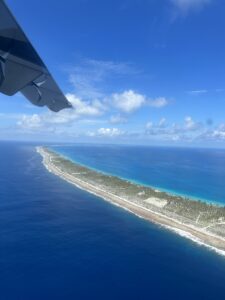By Laurie Reid of LFR Studios
In the spring of 2023 I was thrilled to have the opportunity to visit Kamoka, a Tahitian cultured Pearl farm in French Polynesia. Kamoka piqued my interest some years back when I heard about its responsible Pearl farming practices. Since I’m always in search of material for jewelry making that prioritizes caring for people and the environment, when an opportunity to visit presented itself, I was eager to see operations firsthand.



Tahitian Pearls are cultivated in the oyster Pinctada margaritifera, commonly known as the “black-lipped” oyster. Sometimes marketed as “black Pearls,” they are actually harvested in a surprising range of beautiful colors, including blues, greens, pinks, bronzes, gold, and white. The majority of Tahitian cultured Pearls are cultivated in the lagoons of the Tuamotu and Gambier archipelagos of French Polynesia. Kamoka is located on Ahe, an atoll in the northern part of the Tuamotus.


There are three flights a week between Papeete, the capital of French Polynesia, and Ahe. It’s an hour and a half flight, and the view from the plane is spectacular; the Pacific Ocean is dotted with atolls and the electric blue water of their lagoons. A water lover since before I could even walk, my heart was bursting with excitement and anticipation. As the small plane touched ground on the Ahe airstrip, I felt like the luckiest person in the world. The beauty was truly astounding, otherworldly, and about to be mine for a couple of days. As someone who is deeply affected by color, my eyes felt like they were going to spontaneously combust from the power of the colors. From the Ahe airport I hitched a ride in a dinghy to a sailboat. The sailboat brought me close enough to Kamoka to be picked up and brought to the farm in the Kamoka flat-bottomed skiff.
The center of operations at Kamoka is a semi-open farmhouse built on stilts over the lagoon. It is here that the difficult, highly skilled work of grafting the oysters and harvesting the Pearls is done. It is where the tools needed for grafting are machined and sharpened; where the Pearls are sorted, cleaned, and counted. A small greenhouse is used to grow native plants in an effort to repopulate some native species. Solar panels provide the electricity needed to run the farm, and a rainwater catchment system provides the farm with fresh water for drinking and cooking. Here is also where the communal meals are cooked and eaten around a large central table. There is a constant hivelike productivity happening here. Everyone has a job (or three) to do.

The farmhouse is connected to land by a narrow footbridge. The water below is crystal clear and teeming with colorful reef life. Parrotfish, groupers, angelfish, maxima clams, and blacktip reef sharks abound. I’ll admit, it took a minute to get comfortable with the fact that if I fell off the foot-wide footbridge at night (when the only light is the light of the moon and stars), I’d be swimming with the sharks. It was kindly pointed out that these sharks are so well fed naturally, they’d have no interest in me. A small vegetable garden and four beehives as well as some living quarters are found on the land. Showering is done with rainwater (again from a simple catchment system), and the septic system is a fully compostable DIY setup.

Photo: LFR Studios
The oysters are raised in baskets suspended from ropes in the deeper areas of the lagoon. The baskets protect the oysters from larger predators but not from the many smaller organisms that attach themselves to them. For optimal health, every two months or so the oysters need to be cleaned of these organisms.

Photo: LFR Studios

Photo: LFR Studios
In many Pearl operations these baskets are cleaned by being hosed off, essentially power washed, which violently disrupts the natural habitat of the reef. Kamoka has found a way to clean off the oysters without this disruption. At Kamoka the baskets of oysters are pulled up out of the deeper lagoon waters one at a time by divers and transported to the shallower water closer to the farm house. Here, the oysters are actually cleaned by reef fish that live in these shallower waters. For this to work, the lagoon water surrounding the house must be kept pristine and the fish population carefully protected. For each organism that has attached itself to the oysters, there is a fish that would love to eat it. If the biodiversity of the lagoon is protected, there are plenty of natural cleaners.

Photo: LFR Studios
When I visited Kamoka, the farm was abuzz with nonstop activity. There was a clear sense of joyful community, of people working together to create something purposeful and unique. There were folks with masks and snorkels moving the oyster baskets, a couple of people were giving the veranda a fresh coat of paint, someone was busy preparing the communal noon meal, someone cleaning it up. Someone was tending the beehive, and someone with a hammer and saw worked on repairing the deck. After this work was done there was more to do: spear fishing for dinner, tending the vegetable garden, and counting and sorting Pearls. When the work was done for the day, the crew could enjoy the most eagerly anticipated and well-deserved reward: as the sun dipped toward the horizon, they headed out on the skiff with surfboards.

Photo: Kamoka Pearls

Photo: LFR Studios
The general feeling is one of simplicity and resourcefulness and respect for the land and water and each other. Self-reliance and communal interdependence are carefully intertwined. It’s a beauty born of hard work, intention, and integrity.
This is proprietary content for AGTA and may not be reproduced.
